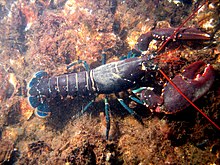|
Reptantia
Reptantia is a clade of decapod crustaceans named in 1880 which includes lobsters, crabs and many other well-known crustaceans. ClassificationIn older classifications, Reptantia was one of the two sub-orders of Decapoda alongside Natantia, with Reptantia containing the walking forms, and Natantia containing the swimming forms (prawns, shrimp and boxer shrimp). However, in 1963 Martin Burkenroad found Natantia to be paraphyletic and invalid, and instead split Decapoda into the two sub-orders of Dendrobranchiata (prawns) and Pleocyemata. Pleocyemata contains all the members of the Reptantia (including crabs, lobsters, crayfish, and others), as well as the Stenopodidea ("boxer shrimp"), and Caridea (true shrimp).[1] Reptantia remains a valid monophyletic grouping, but is now no longer ranked as a sub-order.[2] AnatomyThe name Reptantia means "those that walk", and contains those decapods whose primary mode of locomotion is to walk along a surface using the pereiopods rather than swimming through the water with the pleopods. Despite this, many reptants are able to propel themselves through the water, and many non-reptants can and will walk. SystematicsThe cladogram below shows Reptantia under the sub-order Pleocyemata within the larger order Decapoda, from analysis by Wolfe et al., 2019.[2]
Reptantia comprises the following infraorders:
References
|
||||||||||||||||||||||||||||||||||||||||||||||||||||||||
